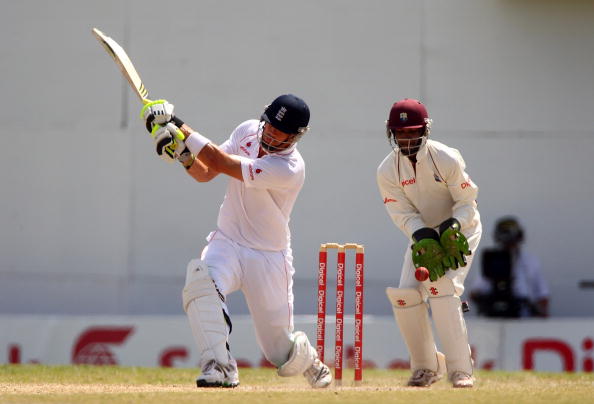
SK Demystifes: Kevin Pietersen's switch hit
The game of cricket has come a long way and just like any sport, cricket too has witnessed a plethora of innovations over the years. There used to be a time when a captain would field long on, a deep backward point, and a deep fine leg and could be certain to an extent that the ball wouldn’t run to the fence. But long gone are those days of assurances, and with the dawn of modern formats, the game has only become more interesting.
The massive run chases at skyscraper like run-rates have left the batsmen with no option but to move out of their shells and try things out of the box to get the ball past the fielders and across to the stands.
This was best depicted when South Africa-born English cricketer Kevin Petersen played the switch-hit for the first time off Muttiah Muralitharan in a test match against Sri Lanka in May 2006. The shot had earlier been attempted by a lot of batsmen but it was Pietersen who perfected the craft. Pakistani batsman Mushtaq Mohammad was the first to experiment with the shot in the mid-1970s while playing for county side Northamptonshire.
The shot then was more of a deflection than a sweep. English batting legend Mike Gatting famously tried it against Allan Border's slow left-arm in the 1987 World Cup final, only to lose his wicket. Andy Flower also had a fair repertoire of deft reverse strokes, and Sachin Tendulkar has also used it too.
Evolution of the switch hit
Pietersen most probably got sick of playing the ball to mid-wicket or deep square leg on a dead turner and went back to the nets and perfected the shot to open up the off side field. For test match scenarios, it was along the ground to change strike and for the shorter formats for boundaries.
Now coming to the shot itself, as soon as the bowler completed his arm action, Pietersen would change his stance and his grip to that of a left-hander. The bottom hand, which is the dominant of the two, would change to the left, and in time, to make contact. And then, he the used power from his right hand (the top hand) and direction and control with his left and voila, he presented to the world the ‘Switch Hit.’
The controversy that arose
The switch-hit was effective, but generated a tremendous debate in the cricketing world. It is one of the most audacious and brilliant innovations that the game of cricket had witnessed in years. A shot of sheer flamboyance that stunned the players, fans and the rule makers the first time it was played.
While some pundits heralded it as an outstanding display of skill, there were certain purists who claimed otherwise. They believed that this unorthodox shot allowed a batsman to change his initial stance, giving him an unfair advantage over the bowler.
However, world cricket’s apex council decided to pronounce on the 'fairness' of the switch-hit. According to the ICC, a batsman is not allowed to set himself to play the switch hit or reverse-sweep either by altering his grip or stance, before the bowler enters his delivery stride. Should the batsmen transgress, as Pietersen clearly did on several occasions, the bowler can choose not to ball, like Dilshan did during England’s tour of Sri Lanka in 2012.
Defending his iconic shot, Pietersen was quoted as saying by ESPN Cricinfo, “Everybody wants brand new ideas, new inventions, and new shots. That is a new shot played today and people should be saying it's a new way to go.”
“Try running in and bowling with your wrong hand if you like. Batsmen wouldn't mind. It would increase their chances of hitting boundaries, just as switching to the 'wrong' stance while batting should, in theory, make it easier for the bowler to take a wicket.”
Extra cover: SK Demystifies: Douglas Marillier's trend-setting scoop shot
Also, the Marylebone Cricket Club (MCC), confirmed legislating against the switch-hit tactic and cited that the shot was perfectly legal in accordance with cricketing laws. The switch-hit saga went on until June 2012, when the ICC declared it to be a legitimate shot. Also, to offer the bowler any compensation, the cricket council ruled that a batsman would be declared LBW if he plays a switch-hit and misses, irrespective of where the ball has pitched.
The mystery unlocked
Pietersen credits the switch hit to his childhood passion, squash tennis. He revealed that he conceives the switch hit as a back-handed squash shot, played using mostly his wrists. His right hand, he uses for power, while the left arm provides him with control and direction over the ball.
As the 36-year-old right-hander says, the switch hit is a shot “where there is method and there is madness.” And quite rightly so. The technique lies in switching over fast and being able to judge the line of the ball in that split second. No captain would ever expect a batsman to hit the ball over the cover region when the backward point is up and the bowler is bowling onto the legs of the batsman. But all Pietersen needs to do is change his grip and he opens up the entire off side field for himself.
The switch-hit is a high-risk stroke and can only be played by a batsman with keen vision and judgement of the ball. The ambidextrous Kevin Pietersen, however, believed it as a shot which defined himself.
